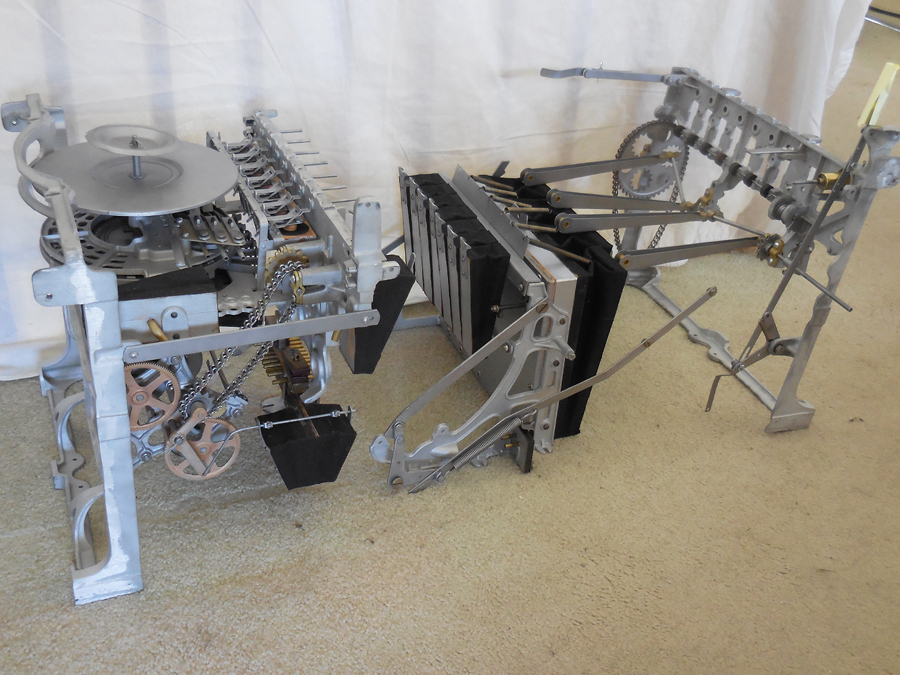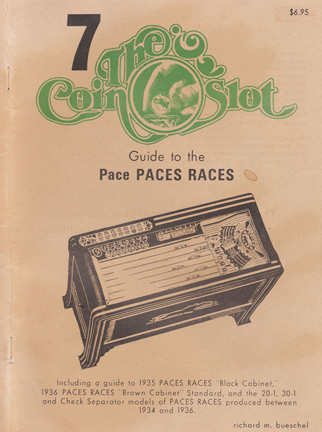Paces Races (1934-1954)
Nothing was ever the same again after PACES RACES. It brought back the floor machines, ultimately to be known as a class of machine called the console. ''Races"-everybody called it that- is both older and newer than most people think. The first "Races" came out a full three years before the electric consoles. The machine paved the way, creating a climate of acceptance for a big floor machine with electric power. The seven-way PACES RACES is a throwback to earlier player piano technology. The chance element is provided by a paper roll that actuates pneumatics all driven by an electric motor. First introduced in 1934, the early black cabinet models of 1934 and 1935 had a lots of bugs. An early serial is 1400. A typical 1935 serial is 2035. Two major redesigns and overhauls led to the classic light cabinet models of 1936 and after, with PACES RACES long being recognized as the definitive coin-operated gambling machine. It still is, with collectors coming to regard it as the "new DEWEY." Prices for the "Races" machines have zoomed in the past few years, and they are rapidly moving into the Victorian floor machine range.
The primary reason for such popularity is that the machine is packed with so much mechanical intelligence. The odds change; seven three-dimensional horses move forward at varying rates, and the payouts have a wide range of values. It is one of the most exciting machines a player can play. Probably the only thing that compares to it is an old Caille or Mills ROULETIE, and even they don't have the play variety of a PACES RACES. By the time of the brown cabinet machines of 1937, the "Races" serials were in the 4500 range, and still they kept climbing. The1937 cabinet is of inlaid dark walnut with thick gold stripes, a masterpiece of the cabinetmaker's art. Serials go into the 5500 range. In 1939, a jackpot payout in the form of a gold award token was added, with serials going over 6500. The final 1940 model was called the "Red Arrow" because of its side panel design. The highest known serial is 6895, although they are said to have gone over 8000.
"Races" had a lot of imitators. The closest was BAKER'S PACERS, actually rebuilt Pace machines in Baker Novelty Company cabinets, sold until 1950. Bally made an all-electric machine that was virtually identical called RAY'S TRACK, sold between 1936 and 1938 with serials going as high as a known 4795. Pace also made specialty models called King Pin Marathon with runners instead of horses, in 1938. Pace sold “Races” out to H.C. Evans in 1944, with Evans bringing out their own versions in 1945 and 1946.
From Slots 1, Richard Bueschel, 1978

A Triumph of Engineering
H. C. EVANS COMPANY
Again Proudly Presents an Outstanding Addition to its Line of Consoles in The New Evans Races, Outstanding in Beauty, Amusement, Earning Ability and Engineering
This console, which has been acclaimed as the greatest racing machine ever produced, has justly earned that reputation after being presented to the entire industry at both public and private showings.
There is no make-believe about this race. Seven horses actually racing, with speed, color and excitement, on a straight-away track in full view of all players. No other console or coin operated machine offers the players this thrill, fun and excitement.
There is a winner every race, with a Sweepstakes jack pol, amounting to $5.50 on a 5c machine, appearing at opportune moments to increase earnings and stimulate play. thereby assuring the operator greater profits and longer life on locations.
All operators are fully aware of the fact that H. C. Evans & Company purchased outright sometime ago from the Pace Manufacturing Company of Chicago all the patents. dies, patterns, etc., covering the original Paces Races. The new Evans Races includes many of the well known features of the original Paces Races, and in addition the noted improvements which have been made by H. C. Evans &- Company since taking over this machine.
The pneumatics on this machine have been reduced by 50°0 and the only ones now used operate the horses and reverse the paper roll, which fact will immediately lend itself to all operators from a service standpoint. Another outstanding feature is the installation on all Evans Races of the well known Musser Brake, which absolutely eliminates slipping or sliding of the horses. All patents, dies, etc. covering this brake have been purchased from the inventor and are now owned exclusively by the Evans Company.
The new Evans Races is built to the same precision engineering as are all H.C. Evans & Company products. and operates on 60 cycle, 110 volt A. C. Information for operation on any other current will be supplied upon request.
DIMENSIONS Height 59 inches Width 42 inches
Depth 30 Inches Weight .. 350 pounds
You Can Buy This Machine With Confidence and Operate It With Pleasure.

The Coin Slot Guide to the Evans EVANS RACES and EVANS LONG SHOT RACES
The maintenance and care of your Evans Race Machine
The thrill of the race, the horses hurtling across the track, the odds changing and that final surge across the finish line under your left hand. Finally, the chattering of payout coins. It all sounds very exciting, and most of it sounds like a Pace RACES RACES. But that's not the case this time. Sure, the machine in question started out as a PACES RACES (See Coin Slot Guides No.7 and No. 16) and then it took its own header. This is the EVANS RACES we're talking about, made by H. C. Evans and Company of Chicago between 1947 and 1954 when the firm went out of business. The buzz words are "horses hurtling across the track" and the finish of the race "under your left hand." On the PACES RACES and on its revamped BAKER'S PACERS the horses run away from the player and finish at the far end of the machine. Not so on EVANS RACES; they run from right to left in full presence of the player or players. That's only the beginning of the changes. When H. C. Evans finally got around to introducing their new console machine at the coin machine show at the beginning of 1947 they had a lot to talk about. They claimed that EVANS RACES was "the console that stole the show," to quote the February 15th issue of THE BILLBOARD. The old-fashioned player-piano pneumatics of the PACES RACES line became electro-pneumatic control on the Evans machine. That meant that play was three times as fast, and operator profits three times as much. Evans added their own "slug proof 7-coin head" and brightened up their EVANS RACES machine far in excess of any racing console that had yet been placed in the market. This machine and its various models are serviced by This Coin Slot Guide.
Fruit of the Family Tree
The first and foremost console race machine was the Pace PACES RACES of 1934-1941. In October 1944, at the height of World War 2, Pace sold out the rights and their remaining inventory in the game to H. C. Evans and Company, and threw in the dies and tooling. Evans immediately went into the production of replacement parts, and promised a "New Evans SUPER DELUXE RACES. Streamlined! New Coin Head! 50 other new features!" after the war was won.
It was logical that Evans would be the firm that would bring PACES RACES back to life in a new format after the war. They were already recognized as one of the largest and most successful I console producers in the coin machine business and had earned the respect of the industry with their electric spinner GALLOPING DOMINOS (See Coin Slot Guide No. 10) and three-reel console.
Bell LUCKY LUCRE (See Coin Slot Guide No. 26) machines. So VE-Day ("Victory in Europe") and VJ-Day ("Victory over Japan") came and went, and Evans came back in 1946 with postwar models of the GALLOPING DOMINOS, BANG TAILS and WINTER BOOK electric consoles (Coin Slot Guide No. 10) as well as the CASINO BELL Console Bell (Coin Slot Guide No. 26). But no race machine.
By the time the game made it to the market in 1947 its name had changed. Now it was EVANS RACES in cash payor free play models in 5c or 25c play. It was also far more elegant and complicated than any PACES RACES ever built. Success with the line led to an improved model in 1948 as the NEW EVANS RACES, backed by a convertible free play or cash pay F R E E P LAY CONVERTIBLE EVANS RACES and a High-payout EVANS LONG SHOT RACES. These are the models that remained in production off and on until 1954.
How to Use This Manual
It seems to have been a tradition at H. C. Evans And Company; while the machines were great the manuals were crummy. The first and only EVANS RACES manual carries a 1947 copyright and combines notoriously poor pictures with a few good line drawings interspersed with an endless array of type written part numbers.
Things didn't get much better when the newer NEW EVANS RACES and its follow-on models were introduced in 1948. Frankly, they got worse. Evans produced a colorful new sales brochure for the line, added some updated ditto machine operating instruction sheets headed "Evans Races" -but still hand typed as a master rather than typeset, mind you -- and stuck the new pieces inside of the 1947 manual and passed the whole makeshift package along with the new machines. The only advantage to this sorry situation is the fact that this material thereby serves and services all of the machines in the line.
This Coin Slot Guide has been reproduced from just such a package as delivered with a NEW EVANS RACES to a Chicagoland operator in 1949. The front cover shows the newer model pictured in the 1948 selling literature, and the page at left reproduces the sales pitch. The next five pages reproduce the newer operating instructions as a straight line reduction to pack it all in, and the remaining pages squeeze the entire manual into whatever room is left. It is hardly a demonstration of the printers art, but it does bring all the data under one cover. The one concession to quality is the enlarged reproduction of the wiring diagram in the center spread as you'll probably need this the most.
